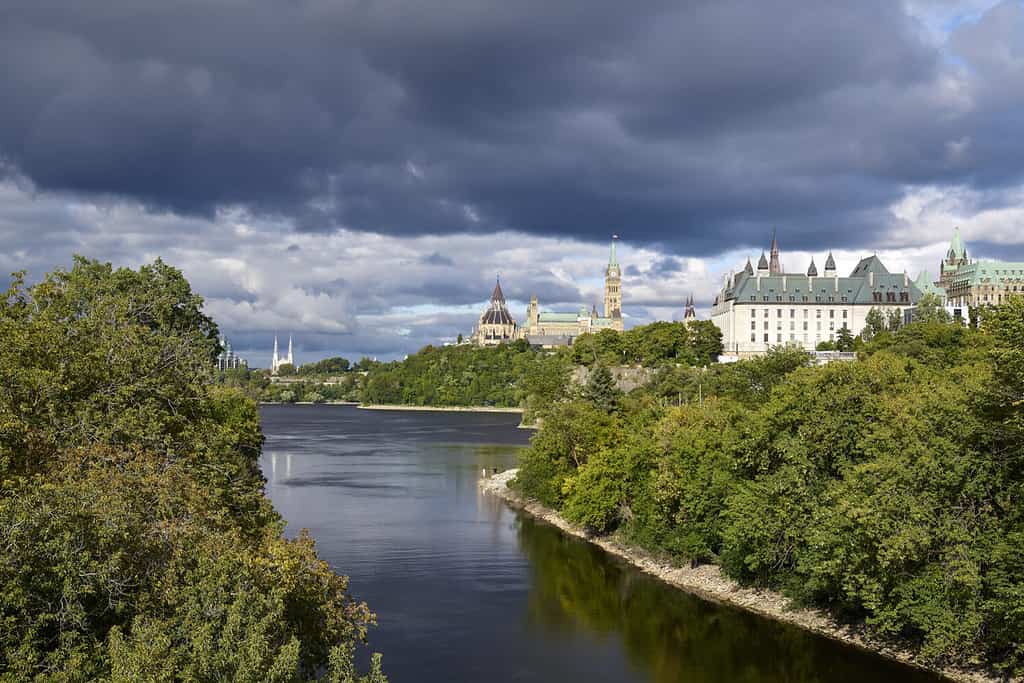The Ottawa River, a majestic waterway that flows through the heart of Canada’s capital, is a natural wonder that captivates locals and visitors alike. Spanning a length of approximately 790 miles (1,271 kilometers), the Ottawa River holds many secrets and surprises within its currents. One intriguing aspect of this iconic river is its width at its widest point, a topic that sparks curiosity among those who appreciate its grandeur. In this article, we will delve into the depths of the Ottawa River to uncover the answer to the question: How wide is the Ottawa River at its widest point?
Exploring the Ottawa River:

The Ottawa River is said to be 4.6 miles wide at its widest point.
©Light and Vision/Shutterstock.com
Before we dive into the details of the Ottawa River’s width, let’s take a moment to appreciate the significance of this natural wonder. The river originates from Lake Capimitchigama in the province of Quebec and flows westward, forming the border between Ontario and Quebec. It eventually merges with the Saint Lawrence River near Montreal, creating a vital waterway that has played a crucial role in the region’s history and development.
The Widest Point of the Ottawa River:
Determining the exact width of a river can be a complex task, as its width can vary depending on factors such as season, water levels, and geological features. In the case of the Ottawa River, its width can fluctuate significantly along its course. However, historical data and estimates provide us with a general understanding of the Ottawa River’s width at its widest point.
The Ottawa River reaches its maximum width near the town of Hawkesbury, located approximately halfway between Ottawa and Montreal. At this point, the river expands to an impressive width of about 24.300 ft (4.6 miles). This breadth showcases the river’s majestic nature, demonstrating its capacity to carve a path through the surrounding landscape.
Factors Influencing Width:
Several factors contribute to the Ottawa River’s width at its widest point. First and foremost is the river’s geological history. Over thousands of years, the river has eroded and shaped the surrounding terrain, resulting in a wide riverbed. Also, the presence of islands, sandbars, and floodplains within the Ottawa River’s course can influence its width, creating variations at different points along its journey.
Another crucial factor that affects the width of the Ottawa River is the flow rate and water levels. During rainy seasons or periods of snowmelt, the river’s width can expand due to increased water volume. Conversely, in drier seasons or periods of low rainfall, the river’s width may decrease as water levels recede.
Significance and Importance:
Understanding the width of the Ottawa River at its widest point holds significance beyond mere curiosity. It highlights the river’s importance as a natural resource, providing a habitat for diverse wildlife and supporting various ecosystems. The Ottawa River also serves as a vital transportation route, historically used for trade and exploration, and continues to be a hub for recreational activities such as boating, fishing, and kayaking.
Width in Comparison to Other Major Canadian Rivers
| River Name | River Width (Widest Point) |
|---|---|
| Ottowa River | 4.6 miles |
| St. Lawrence River | 62 miles |
| Mackenzie River | 18.6 miles |
| Fraser River | 31 miles |
| Yukon River | 3,280 feet |
St. Lawrence River
The St. Lawrence River widens to around 62 miles (100 km) near Sept-Iles, close to the mouth of the Moisie River.
Mackenzie River
The Mackenzie River has a width of about 18.6 miles (30 km). The Mackenzie River, where the western end of the Great Slave Lake narrows, is about 6 miles (10 kilometers) wide.
Fraser River
The Fraser River drains a region of about 92,000 square miles (238,000 square kilometers) in central British Columbia. The Fraser River lowland broadens to a width of about 31 miles (50 km) to the west.
Yukon River
Between the sonar stations on the Yukon River in Alaska, the river is approximately 3,280 feet wide.
In Conclusion:
The Ottawa River, with its rich history and breathtaking beauty, is a symbol of Canadian heritage and natural splendor. While the width of the Ottawa River at its widest point can vary, reaching approximately 24,300 ft (4.6 miles), it is a testament to the river’s majesty. As we embrace the awe-inspiring width and breadth of this magnificent waterway, let us also appreciate its significance in shaping the landscapes and communities it traverses. Whether you’re a local resident or a curious traveler, the Ottawa River’s grandeur will continue to inspire and captivate all who encounter its majestic flow.
The photo featured at the top of this post is © Kaitlyn Philip/iStock via Getty Images
Thank you for reading! Have some feedback for us? Contact the AZ Animals editorial team.







